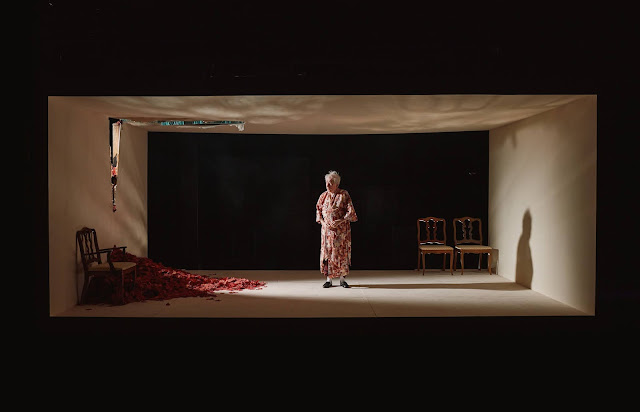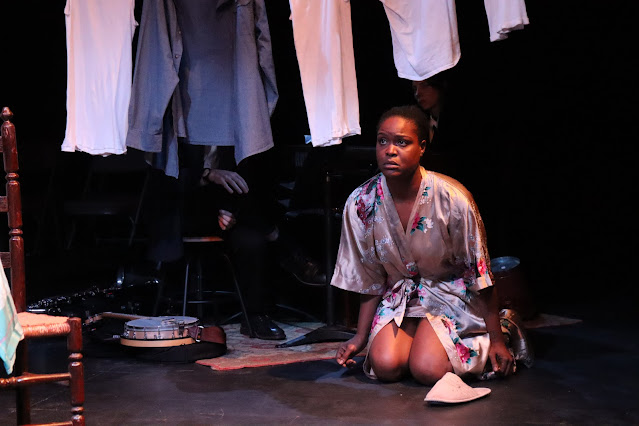The Dark Outside
Written by Bernard Kops
Directed by Jack Serio
155 First Avenue (between 9th and 10th Streets), Manhattan, NYC
November 6-28, 2021
 |
| Austin Pendleton in The Dark Outside, by Bernard Kops, directed by Jack Serio, presented by Theater for the New City. Photo by Emilio Madrid. |
A father's birthday brings a family together, literally and otherwise, in the world premiere of
The Dark Outside by celebrated playwright Bernard Kops, who will himself turn 95 on the final day of the show's run. Since his career began in the 1950s, London-born Kops has written more than 40 plays, in addition to a pair of autobiographies and numerous novels, books of poetry, and radio plays, and he is the first Jewish recipient of a Civil List pension, awarded by the Queen, for his services to literature. In the intimate, lyrical
The Dark Outside, encounters with the darkness of the title need not mean capitulation.
Set in England,
The Dark Outside unfolds at the family home belonging to Paul (storied performer, director, playwright, and teacher of acting Austin Pendleton), a tailor who lost an arm when struck by a drunk driver, and his loving, Brooklyn-born wife, Helen (Katharine Cullison, for whom Kops wrote the part, modeling the character on his own wife, Erica). Paul and Helen's three children, Sophie (Brenna Donahue), Ben (Jesse McCormick), and Penny (Kathleen Simmonds), are returning home for the abovementioned birthday of the paterfamilias, and they arrive bearing more unspoken troubles than gifts. Paul views the outside world as falling into ruin, a place of dying streets and lost and dying young people, and the number of times that the words desperate and desperation recur in the dialogue would seem to lend credence to his perspective. Counterbalancing this seeming encroachment of entropy, however, stands the mulberry tree in their garden, to which it has become a family tradition to unburden oneself. The tree, old—hundred of years old—but alive, provides a steady presence, a still point amidst the chaos of life. In this, the tree both evokes family—and perhaps on an individual level Helen, the backbone of this particular family—and stands outside of it, hinting at the transience of human crises in the very scale of its lifespan. Sophie is the first whom we discover to be carrying a hidden sadness to the family gathering, but not, it will transpire, the only one, as evinced over the course of the play by multiple revelations (not all nearly as traumatic as Sophie's) and at least one epiphany.
 |
| The mulberry tree outside drops leaves in The Dark Outside, by Bernard Kops, directed by Jack Serio, presented by Theater for the New City. Photo by Emilio Madrid. |
Scenic designer Walt Spangler has created a set that is a work of art in itself: a white box with no back wall, a few chairs, and a crack straddling the ceiling and wall on one side, under which a pile of red-hued leaves has accumulated, a few remaining caught in the crack. (It felt a bit like looking at an art installation while waiting for the play to start.) The set, which serves for upstairs and downstairs, inside and outside, sometimes gives a feeling of confining enclosure, and sometimes the embrace of safety. Some of this variability owes itself to the lighting, which bathes the space in an antiseptic white, except when it takes on warm, golden tones for a character's conversation with the tree.
 |
| Katharine Cullison and Austin Pendleton in The Dark Outside, by Bernard Kops, directed by Jack Serio, presented by Theater for the New City. Photo by Emilio Madrid. |
The Dark Outside perceptively reflects the deep roots and unequal dynamics of family bonds. Sophie and Ben appear close, returning together to the role play and singing of their childhood (the family as a whole often communicate in snatches of song and poetry) without showing the same closeness with Penny, the successful, happily married sibling. Similarly, Paul lavishes noticeably more affection on his daughters than on his son. Importantly however, none of this remains static, a welcome complexity reflected in the individual characters as well, who are never less than messily human. Amidst sensitive and feeling performances by all concerned, those of Cullison and Simmonds, as women consistently called upon to be strong for others, particularly stand out in a cast of characters who face aging, death, love, and (re)birth. In this production, the family home may be permeable to the darkness outside its walls—witness that crack—but it remains a refuge nonetheless.
-John R. Ziegler and Leah Richards






Comments
Post a Comment